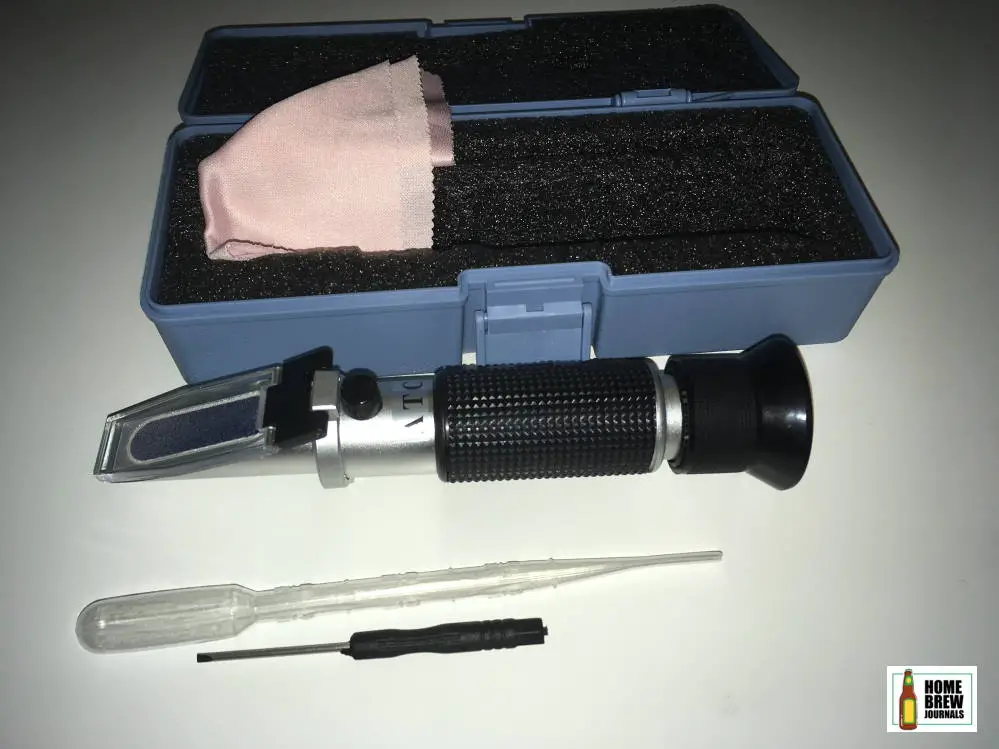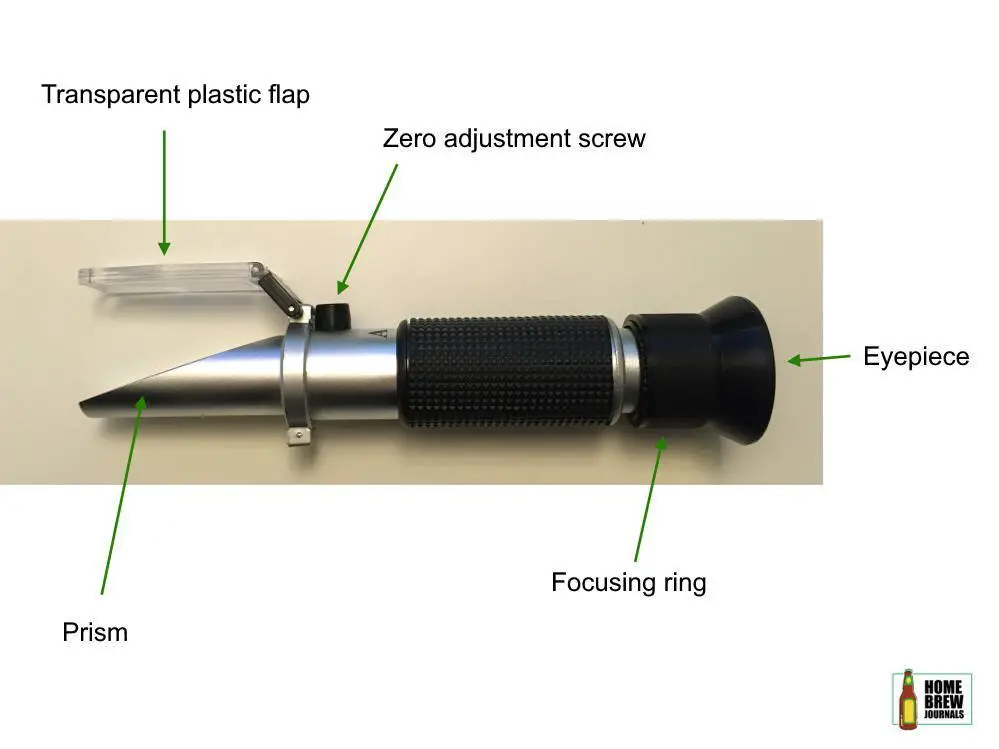A refractometer is an instrument used to measure the concentration of a given substance in an aqueous solution. Brewers commonly use refractometers to measure sugar concentration in the wort, which can then be used to calculate beer or wine’s alcohol content.
Refractometers are used widely used in the food industry. They are available with different scales to measure the concentration of solutions including fruit juices, vegetable oils, saline solutions, soy milk, honey and of course, alcohol.
At this point, it’s worth mentioning that, although there are refractometers available which directly measure the percentage of alcohol in water (%ABV) they are NOT suitable for measuring the alcohol content of beer.
This is because, in addition to alcohol, beer also contains sugar which messes up the reading. Refractometers used by brewers measure sugar concentration, which is used to calculate the amount of alcohol present.
In this post, we learn how refractometers work, what type of refractometer you need for home brewing and how to use a refractometer to measure the amount of alcohol in your beer or wine.

How does a refractometer work?
Refractometers work by an effect called refraction, which refers to how light changes direction as it passes from one transparent substance to another.
For example, if you’ve ever noticed that drinking straws look bent when you place them in a glass of water or soda, that’s because of refraction.
Lenses are another example of refraction, bending light to magnify images and bring them into focus.
The amount that light is refracted by depends on the refractive indexes of the materials that it is passing through. When sugar is dissolved in water, the refractive index of the solution increases with concentration. The more sugar is present, the greater the angle of refraction.
A refractometer contains a prism mounted in an aluminium body with an eyepiece and a scale marked on it.
When there is no liquid on the prism, the entire scale a pale greyish blue colour, when a few drops of water are placed on the prism, light entering the refractometer is bent causing the lower part of the scale to become white.
The refractometer is calibrated so that when distilled water is placed on the prism, the border between the blue and white areas bisects the scale at precisely zero Brix.
When a few drops of a sugar solution are placed on the prism, the light is refracted more, and the border between the blue and white areas lines up with a different point on the scale. The position varies according to the amount of sugar dissolved in the water.
The scale is graduated in Brix units, which is equivalent to the percentage of sucrose (a type of sugar) dissolved in the water.
What type of refractometer do you need for home brewing?
Refractometers for home brewing are sometimes referred to as Brix meters or saccharometers.
They have a scale in Brix and sometimes a second scale marked in specific gravity.
Most refractometers used for brewing include automatic temperature compensation which means that there’s no need to wait for the wort to cool down.
I use a handheld refractometer like this one by ATC which is available from Amazon and comes complete with a small pipette for taking samples and a handy storage case. As you can see in the photos, it has an adjustable eyepiece for focusing, which is especially handy if you wear glasses.

How to measure alcohol with a refractometer
As mentioned at the start of the post, brewers’ refractometers measure the percentage of sugar dissolved in the wort.
As the wort ferments, yeast converts the sugar in the wort into alcohol. This means that there is less sugar in the finished beer than there was in the wort before fermentation started.
To calculate the percentage alcohol by volume of your beer, you simply need to measure the amount of sugar in the wort before pitching the yeast and then measure it again once fermentation has stopped.
Refractometers measure the percentage of sugar in the wort in Brix. This is very accurate when measuring unfermented wort but, once fermentation starts, the alcohol affects the reading meaning that the Brix reading needs to be adjusted.
Luckily there are several mathematical formulas available online which can be used to correct the Brix reading. The calculator below converts the Brix readings and calculates the amount of alcohol present in your finished beer in ABV%.
To measure the alcohol content with a refractometer, you simply take a Brix reading of the unfermented wort and then take another reading once fermentation is complete. You can then plug these values into the calculator below to determine the percentage of alcohol in your beer (%ABV).
The calculator has a field for the Wort Correction Factor which I’ll explain later in the post. If you don’t know the correction factor of your refractometer yet, you can just leave it at one for now since it only has a minimal effect on the calculation.
There’s more information about the formulas used here and here.
How to take a refractometer reading step-by-step
1. Calibrate the refractometer using distilled water
Your refractometer was calibrated in the factory, but you should check the calibration each time you use it to get the most accurate readings possible.
Open the transparent plastic flap that covers the prism and put two or three drops of distilled water on it.
Close the flap and hold the refractometer up to the light.
Look through the eyepiece and turn the focusing ring until you can clearly see the Brix scale illuminated blue and white as shown in the picture.
The borderline between the white and blue sections should cross the scale at zero Brix. If not, you can adjust the refractometer by removing the small plastic cap which covers the calibration screw and using a small screwdriver to turn the screw (see photo).
Once you are happy that the refractometer is calibrated, you should replace the plastic cap before moving on to the next step.
2. Dry the refractometer
The next step is to carefully dry the prism using a soft cloth.
This is important since, if there is any distilled water left on the prism when you add your sample of wort, it will affect the measurement.
3. Take a small sample of wort using a wine thief, pipette or metal spoon
One of the main advantages of using a refractometer is that you only need a few drops of wort.
Before taking a sample, make sure that the pipette, metal spoon or wine thief have been thoroughly sanitised and left to dry before dipping it into the wort. Poor sanitation is the easiest way to mess up a batch of beer.
4. Place a few drops of wort on the prism
Open the transparent plastic flap which covers the prism, place a few drops of wort on the prism and then close the flap again so that the sample is spread evenly across the prism.
5. Hold the refractometer up to the light and take a reading
Hold the refractometer up to the light and look through the eyepiece. If necessary, adjust the focus using the focusing ring.
Take a Brix reading by looking at where the blue and white sections cross the scale.
6. Clean and dry the refractometer after each use
Clean and dry the prism with distilled water and a soft cloth to remove all traces of wort before placing the refractometer back in its case.
How to accurately measure alcohol with a refractometer
As we have seen, refractometers are very easy to use but, as with all precision instruments, there are a few factors which you should bear in mind.
Automatic temperature correction
Unlike hydrometers which need to be corrected for the temperature of the wort using an online calculator like this one, most brewers’ refractometers feature automatic temperature compensation.
However, the temperature compensation only works correctly up to a maximum temperature of 30ºC (86 Fahrenheit).
This isn’t usually an issue, but if you want to take a gravity of reading of boiling wort, you should let it cool to below this temperature before reading the refractometer.
Luckily, since the sample size is so small, this only takes a few seconds.
Wort Correction Factor
Refractometers measure the percentage of sucrose (a type of sugar) in water to give a reading in Brix.
Wort is made up of a mixture of different sugars, mostly glucose but also maltose, fructose and sucrose. These sugars have a slightly different refractive index than sucrose. This tiny difference in refractive index causes the Brix reading to be slightly inaccurate.
The so-called Wort Correction Factor is used to ensure that the measurement is as accurate as possible. For most refractometers, the correction factor is around 1.004, but it does vary somewhat from refractometer to refractometer.
To calculate the correction factor, you take a sample of unfermented wort and compare the Brix reading from your refractometer with the Brix or SG reading from your hydrometer. You can download a spreadsheet from Brewers Friend, which calculates the correction factor.
Take several measurements
To get the most accurate measurement possible, you should always take at least two or three measurements.
One of the advantages of using a refractometer instead of a hydrometer, especially when brewing small batches, is the fact that you only need to take a very small sample of wort or beer.
You only need two or three drops of wort to take a measurement with a refractometer, whereas you need around 200ml of wort to measure with a hydrometer.
